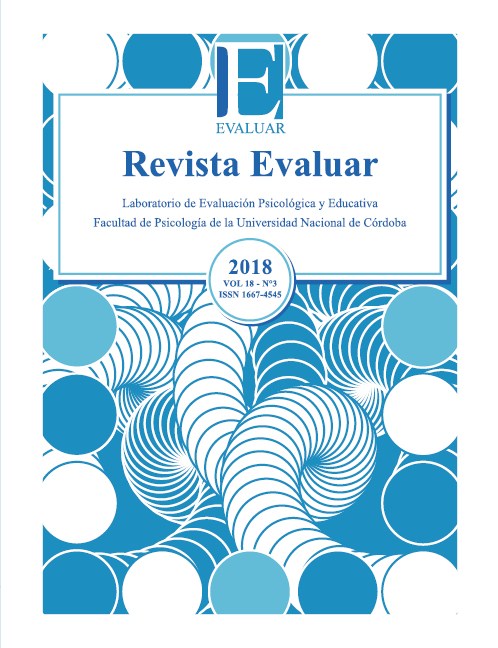Best Practices in the Use of Bifactor Models: Conceptual Grounds, Fit Indices and Complementary Indicators
DOI:
https://doi.org/10.35670/1667-4545.v18.n3.22221Palabras clave:
confirmatory factor analyses, bifactor models, PANAS, complementary statistical fit indicesResumen
Bifactor models have gained increasing popularity in the literature concerned with personality, psychopathology and assessment. Empirical studies using bifactor analysis generally judge the estimated model using SEM model fit indices, which may lead to erroneous interpretations and conclusions. To address this problem, several researchers have proposed multiple criteria to assess bifactor models, such as a) conceptual grounds, b) overall model fit indices, and c) specific bifactor model indicators. In this article, we provide a brief summary of these criteria. An example using data gathered from a recently published research article is also provided to show how taking into account all criteria, rather than solely SEM model fit indices, may prevent researchers from drawing wrong conclusions.
Descargas
Citas
Arias, V. B., Jenaro, C., & Ponce, F. P. (2018). Testing the generality of the general factor of personality: An exploratory bifactor approach. Personality and Individual Differences, 129, 17-23. doi: 10.1016/j.paid.2018.02.042
Bäckström, M., & Björklund, F. (2016). Is the general factor of personality based on evaluative responding? Experimental manipulation of item-popularity in personality inventories. Personality and Individual Differences, 96, 31-35. doi: 10.1016/j.paid.2016.02.058
Bonifay, W., Lane, S. P., & Reise, S. P. (2017). Three concerns with applying a bifactor model as a structure of psychopathology. Clinical Psychological Science, 5(1), 184-186. doi: 10.1177/2167702616657069
Davies, S. E., Connelly, B. S., Ones, D. S., & Birkland, A. S. (2015). The general factor of personality: The “Big One,” a self-evaluative trait, or a methodological gnat that won’t go away? Personality and Individual Differences, 81, 13-22. doi: 10.1016/j.paid.2015.01.006
Gignac, G. E. (2016). The higher-order model imposes a proportionality constraint: That is why the bifactor model tends to fit better. Intelligence, 55, 57-68. doi: 10.1016/j.intell.2016.01.006
Hancock, G. R., & Mueller, R. O. (2001). Rethinking construct reliability within latent variable systems. In R. Cudeck, S. du Toit & D. Sorbom (Eds.), Structural equation modeling: Present and future—A Festschrift in honor of Karl Joreskog (pp. 195-216). Lincolnwood, IL: Scientific Software International.
Morgan, G. B., Hodge, K. J., Wells, K. E., & Watkins, M. W. (2015). Are fit indices biased in favor of bi-factor models in cognitive ability research?: A comparison of fit in correlated factors, higher-order, and bi-factor models via Monte Carlo Simulations. Journal of Intelligence, 3(1), 2-20. doi: 10.3390/jintelligence3010002
Rodriguez, A., Reise, S. P., & Haviland, M. G. (2016). Applying bifactor statistical indices in the evaluation of psychological measures. Journal of Personality Assessment, 98(3), 223-237. doi: 10.1080/00223891.2015.1089249
Seib-Pfeifer, L.-E., Pugnaghi, G., Beauducel, A., & Leue, A. (2017). On the replication of factor structures of the Positive and Negative Affect Schedule (PANAS). Personality and Individual Differences, 107, 201-207. doi: 10.1016/j.paid.2016.11.053
Stucky, B. D., Thissen, D., & Edelen, M. O. (2013). Using logistic approximations of marginal trace lines to develop short assessments. Applied Psychological Measurement, 37(1), 41-57. doi: 10.1177/0146621612462759
Descargas
Publicado
Cómo citar
Número
Sección
Licencia
Derechos de autor 2018 Pablo Ezequiel Flores-Kanter, Sergio Dominguez-Lara, Mario Alberto Trógolo, Leonardo Adrián Medrano

Esta obra está bajo una licencia internacional Creative Commons Atribución 4.0.
Revista Evaluar aplica la Licencia Internacional de Atribuciones Comunes Creativas (Creative Commons Attribution License, CCAL). Bajo esta licencia, los autores retienen la propiedad de copyright de los artículos pero permiten que, sin que medie permiso de autor o editor, cualquier persona descargue y distribuya los artículos publicados en Evaluar. La única condición es que siempre y en todos los casos se cite a los autores y a la fuente original de publicación (i.e. Evaluar). El envío de artículos a Evaluar y la lectura de los mismos es totalmente gratuito.




_(3).jpg)



.jpg)



